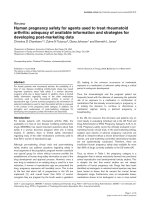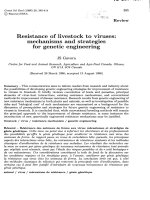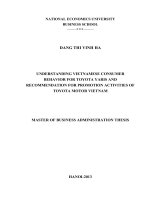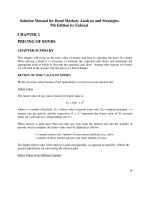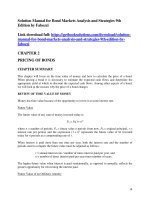SWOC analysis and strategies for promotion of organic paddy farming in cauvery delta zone of Tamil Nadu, India
Bạn đang xem bản rút gọn của tài liệu. Xem và tải ngay bản đầy đủ của tài liệu tại đây (389.54 KB, 7 trang )
Int.J.Curr.Microbiol.App.Sci (2019) 8(5): 427-433
International Journal of Current Microbiology and Applied Sciences
ISSN: 2319-7706 Volume 8 Number 05 (2019)
Journal homepage:
Original Research Article
/>
SWOC Analysis and strategies for Promotion of Organic Paddy Farming in
Cauvery Delta Zone of Tamil Nadu, India
D. Karpagam1* and R. Jansirani2
1
Department of Agricultural Extension and Rural Sociology, 2Department of Sustainable
Organic Agriculture, Tamil Nadu Agricultural University, Coimbatore-641003, India
*Corresponding author
ABSTRACT
Keywords
SWOC,
Organic paddy
farming,
Cauvery delta zone,
Opportunities and
Challenges
Article Info
Accepted:
04 April 2019
Available Online:
10 May 2019
SWOC analysis is a strategic planning method used to research external and internal
factors which affect company success and growth. Firms use SWOC analysis to determine
the Strengths, Weaknesses, Opportunities and Challenges of the firm, products and
competition. A study was conducted to investigate the prospects of organic paddy farming
in Cauvery Delta Zone of Tamil Nadu for SWOC analysis on organic paddy farming. 180
organic paddy farmers were selected by proportionate random sampling technique.
Majority of the organic paddy framers perceived and ranked low cost of production (I
rank), sustainability (II rank) and use of indigenous technologies (III rank) were strengths.
Weaknesses include inadequate technology, lower yield and less awareness were first,
second and third rank respectively. Opportunities perceived by majority of organic paddy
farmers were growing environmental concern (I rank), growing health awareness (II rank)
and increasing market demand (III rank). Costly and complex organic certification process
(I rank), weed problems (II rank) and most of the fields are contiguous and problem of
contamination (III rank) were the challenges as perceived by organic paddy farmers. Based
on the result of SWOC, strategies were suggested for the development of organic paddy
farming in research extension, production, processing and marketing sectors.
(Opportunities, and Challenges) Rao (2016).
A SWOC analysis was employed for
identifying the strengths, weaknesses,
opportunities, and Challenges as perceived by
the organic paddy farmers involved in
Organic Faddy Farming in Cauvery Delta
Zone of Tamil Nadu. This analysis is
expected to highlight the points for an in
depth understanding of the situation in its
totality, which in turn helps the top
administrators, planners of state government,
Introduction
SWOC (Strength, Weakness, Opportunities
and Challenges) analysis is a process that
identifies an organization’s strengths,
weaknesses, opportunities and Challenges. It
is a basic analytical framework that assesses
what an entity (usually a business, farm,
industry or product) can and cannot do, for
factors both internal (Strengths and
Weaknesses)
as
well
as
external
427
Int.J.Curr.Microbiol.App.Sci (2019) 8(5): 427-433
scientists to take strategic decision to
overcome the weaknesses and challenges in
organic paddy farming. Strengths were
categorized as internal helpful factors and
weaknesses as internal hindering factors of
organic paddy farming. Opportunities were
external helpful factors and Challenges the
external harmful factors.
Internal External
Helpful
STRENGTHS
The formula for RBQ calculation is as follows
(fi)(n+1-i)x100
RBQ =
Nn
Where,
fi - Frequency of organic paddy farmers for ith
rank of SWOC parameters
N – Number of organic paddy farmers
n – Number of ranks
Harmful
WEAKNESSES
Results and Discussion
OPPORTUNITIES CHALLENGES
SWOC analysis on organic paddy farming
In order to understand the nature of the
Strengths, weaknesses, Opportunities and
Challenges of organic paddy farming as
perceived by the organic paddy farmers, rank
based quotients were computed and the values
had been presented in Table 1 to 4.
Materials and Methods
This study was conducted in Cauvery Delta
Zone (CDZ) of Tamil Nadu for considering
the maximum area under Paddy cultivation.
Thanjavur, Thiruvarur and Tiruchirappalli
Districts were selected purposively, due to the
maximum number of certified organic paddy
farmers. For studying the strengths,
weaknesses, opportunities and challenges,
180 organic paddy farmers were selected by
proportionate random sampling technique. A
schedule was prepared to unearth the SWOC
of organic paddy farming. the perceived
responses of the farmers under each
parameter were listed.
The strategy was designed with the following
interventions based on SWOC analysis for
efficient production of organic paddy farming
in Cauvery Delta Zone of Tamil Nadu.
Strategies for promotion of organic paddy
farming
Research intervention
The following intervention on research to be
needed for promotion of organic paddy
farming.
Nine important strengths, weaknesses,
opportunities and challenges (Fig. 1) were
identified by applying Rank Based Quotient
(RBQ) developed by Sabaratnam (1998). The
data obtained from the organic paddy farmers
regarding
strengths,
weaknesses,
opportunities and challenges parameters in
organic paddy farming was quantified i.e. the
number of organic paddy farmers who gave
the particular rank were used for calculation
of RBQ.
Documentation and validation of indigenous
technologies
Conserve traditional paddy varieties
Take up research on organic paddy farming
for its promotion
Quality control of organic inputs
Tested the organic inputs in trial basis for
large scale adoption.
428
Int.J.Curr.Microbiol.App.Sci (2019) 8(5): 427-433
Table.1 Strengths of Organic paddy farming perceived by organic paddy farmers
S.
No.
Strength
Ranks
I
II
III
IV
V
38
30
36
33
35
36
46
1
2
3
Sustainability
Quality Product
High social value
33 38
23 27
4
Low cost of
production
Improve soil health
40 42
59
12
41 41
33
19
5
6
7
8
9
Preserves traditional
paddy varieties with
high medicinal
values
Use of indigenous
technologies
Production inputs are
chiefly available
Huge demand by
customers
20
VII
31
38
23
10
17
20
13
43 32
VI
VIII
45
IX
RBQ
Rank
28
77.655
70.062
32.407
II
V
VII
80.618
I
70.494
IV
29.629
IX
77.037
III
26
37
40
43
35
52
45
12
12
35
34
38
49
35.494
VI
28
18
29
18
36
51
31.790
VIII
Majority of the organic paddy framers perceived low cost of production (I rank) sustainability (II rank) and
use of indigenous technologies (III rank) were strengths
Table.2 Weaknesses of organic paddy farming perceived by organic paddy farmers
S.
No.
1
2
3
4
5
6
7
8
9
Weakness
Ranks
I
Inadequate
technology
Less awareness
Low yield
Expensive product
Lack of established
markets
Labour shortage
II
III
IV
V
43 43
53
26
15
42 40
30 42
43
15
28
34
17
35
10
24
28
34
34
18
28
26
29
32
20 15
25
42
25 35
44
15
Lack of clarity in
organic policy
High cost of inputs
Lack of storage
facilities
20
VI
V II
VIII
36
IX
54
RBQ
82.284
Rank
I
79.753
73.210
II
III
29.012
67.839
VII
V
72.778
IV
16
44
43
11
31
35
35.679
VI
19
7
22
50
56
26
25.494
VIII
33
57
65
23.704
IX
5
Majority of the organic paddy farmers perceived inadequate technology (I rank), lower yield (II rank)and less
awareness (III rank)were weaknesses.
429
Int.J.Curr.Microbiol.App.Sci (2019) 8(5): 427-433
Table.3 Opportunities of organic paddy farming perceived by organic paddy farmers
S. No.
Opportunities
Ranks
I
II
III
IV
V
VI
37 28
24
31
42
18
25
32
35
30
20
VII
VIII
IX
RBQ
73.642
Rank
III
65.062
IV
73.951
II
74.815
I
1
Increasing market demand
2
Growing purchase power of
consumers
3
Growing health awareness
33 28
31
41
26
21
4
Growing environmental
concern
Premium Price
Sustainable use of resources
32 24
36
45
28
5
10
22
37
35
25
40
38
46
52
29.568
45.185
VIII
VI
52
46
39
43
24.012
IX
26
49
39
40.803
VII
64.074
V
5
6
7
Development of organic
paddy processing centres
8
Group certification Under
PGS
Periodical training on
organic farming at TNAU
9
35 30
28 26
12
15 19
45
28
32
38
27
14
Opportunities perceived by majority of organic paddy farmers were growing environmental concern (I rank),
growing health awareness (II rank) and increasing market demand (III rank).
Table.4 Challenges of organic paddy farming perceived by organic paddy farmers
Ranks
S. No.
Challenges
1
2
High cost of organic food
Costly and complex organic
certification process
Most of the fields are contiguous
and problem of contamination
Low awareness about organic
foods
Push for GMOs and Agro
chemicals
Lack of Organic fertilizer
Weed problems
Pest and disease problems
Maintaining organic standards and
certification process
3
4
5
6
7
8
9
I
II
III
IV
V
40 37
32
46
25
38 29
35
30
38
25
42
26
9
10
34
42
28
15
28
30
40
62
17
25
48
59
10
VI
VII
VIII
IX
RBQ
Rank
16
53
49
62
24.136
79.074
VIII
I
75.864
III
10
31
31
50
68
21.420
IX
39
42
59
40
25.062
VII
10
68.025
76.729
68.210
61.481
V
II
IV
VI
20
64
35
19
22
Costly and complex organic certification process (I rank), weed problems (II rank)and Most of the fields are
contiguous and problem of contamination (III rank)were the challenges as perceived by organic paddy farmers.
430
Int.J.Curr.Microbiol.App.Sci (2019) 8(5): 427-433
Fig.1 SWOC Analysis on organic paddy farming
431
Int.J.Curr.Microbiol.App.Sci (2019) 8(5): 427-433
Extension intervention
Marketing intervention
More awareness programme has be conducted
to empower the people on benefits of organic
paddy farming there by increasing the area
under organic paddy farming.
The following market interventions may be
carried out to overcome the weaknesses and
challenges faced by the organic paddy
farming.
Create the awareness about the importance
of organic products.
Provide training and method demonstration
on production of organic inputs for organic
paddy farming.
Provide preseason training on organic
paddy farming technologies
Develop a model village of organic paddy
farming as whole village concept.
Establish separate market outlet for organic
paddy and its by products.
Establish separate warehouse for storage of
organic paddy
Marketing system has to be regulated and
strengthened much to the benefit of the
organic paddy farmers.
In conclusion, low cost of production,
sustainability and use of indigenous
technologies were strengths. Inadequate
technology, lower yield and less awareness
were weaknesses. Opportunities were
growing environmental concern, growing
health awareness and increasing market
demand. Costly and complex organic
certification process, weed problems and most
of the fields are contiguous and problem of
contamination were the challenges as
perceived by organic paddy farmers. Based on
the result of SWOC, to overcome the
weaknesses and face the challenges strategies
to be followed such as documentation and
validation of indigenous technologies,
Develop a model village of organic paddy
farming as whole village concept. Provide
production subsidy for organic paddy seed
production and procure the same and sell to
other organic paddy farmers with subsidised
rate, Provide hands-on training on processing
and value addition in organic paddy, Establish
separate market outlet for organic paddy and
its byproducts etc.
Production intervention
Provide production subsidy for organic
paddy seed production and procure the same
and sell to other organic paddy farmers with
subsidised rate.
Provide subsidy for purchase for purchase
of livestock or give to organic farmers at
free of cost
Provide clear cut and simplified organic
farming policy
Reduce the cost of organic certification
Processing intervention
Develop organic paddy processing centres
at block level
Provide hands-on training on processing
and value addition in organic paddy
Supply of organic paddy processing
machineries at subsidised rate.
Provide training cum demonstration on
maintenance of processing machineries of
organic paddy.
References
Rao, B. M. 2016. SWOT analysis of Bt
Cotton cultivation in Andhra Pradesh.
432
Int.J.Curr.Microbiol.App.Sci (2019) 8(5): 427-433
The Andhra Agriculture Journal. 63
(1): 219-225
Sabaratnam VE. 1998. Manual on field
experience
training
for
ARS
Scientists, National Academy of
Agricultural
Research
and
Management, Hyderabad.
How to cite this article:
Karpagam, D. and Jansirani, R. 2019. SWOC Analysis and strategies for Promotion of Organic
Paddy Farming in Cauvery Delta Zone of Tamil Nadu, India. Int.J.Curr.Microbiol.App.Sci.
8(05): 427-433. doi: />
433


